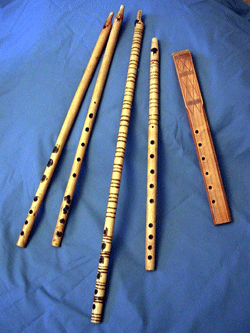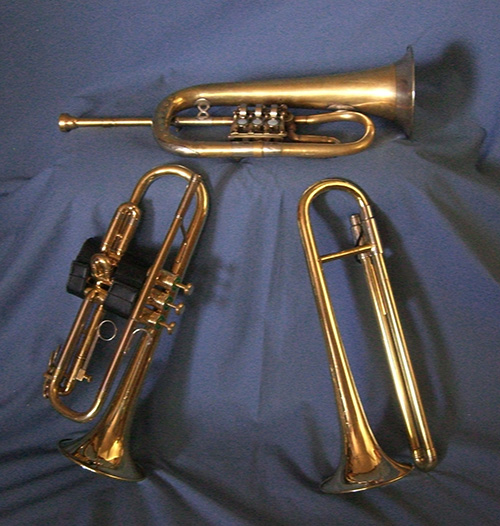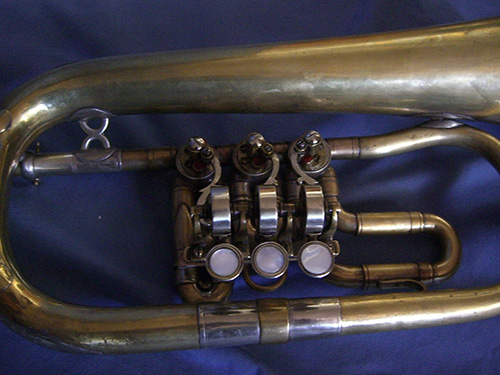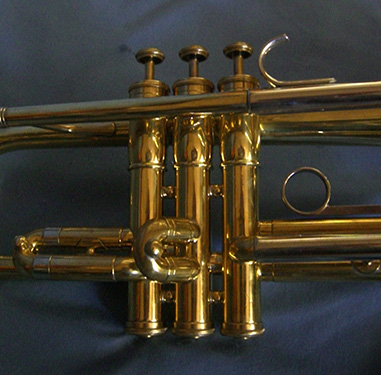FLUTES
& BRASS
Here are the flutes and brass instruments that Todd performs and records with:
* = Recommended listening
All instruments can be entered into www.youtube.com to see video performances
by musicians from around the world
-- DOUBLE-CLICK ON PHOTOS TO ENLARGE --
Bansori Flutes (India)
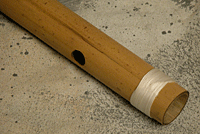
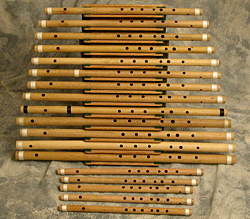 These are diatonic bamboo flutes built for me by an excellent flute maker in California, Jeff Whittier. As you can see, they come in a variety of sizes and can have six or seven holes. The different sizes allow you to play in diffent keys and in different ranges.
These are diatonic bamboo flutes built for me by an excellent flute maker in California, Jeff Whittier. As you can see, they come in a variety of sizes and can have six or seven holes. The different sizes allow you to play in diffent keys and in different ranges.
Even though these are technically one-key flutes, you can play half-tones and quarter-tones by partially covering the holes with your fingers. The seven-hole flutes enable you to bend notes into the octave. The seventh hole is played with the pinkie of your right hand and is generally only used on smaller flutes. Although these are simple flutes, by rolling your fingers off the holes, you are able to bend notes like a string player.
East Indian players use this technique to imitate the qualities of the human voice. All bamboo flutes in this section are wrapped with nylon cord (see close-up) and periodically oiled with mustard seed oil or walnut oil to prevent cracking.
* Hari Prasad Chaurasia, G.S. Sachdev, Steve Gorn
Dizi (Dudze) (China)
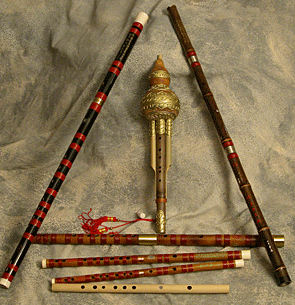 These are side-blown bamboo flutes (bottom and left of photo and close-up), similar to the Indian Bansori flutes. They are believed to have originated in central Asia over 2000 years ago. Their characteristic sound is created by an extra hole with a very thin piece of rice paper over it, which vibrates and creates a
These are side-blown bamboo flutes (bottom and left of photo and close-up), similar to the Indian Bansori flutes. They are believed to have originated in central Asia over 2000 years ago. Their characteristic sound is created by an extra hole with a very thin piece of rice paper over it, which vibrates and creates a 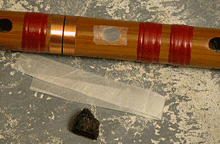 buzzing sound. The rice paper is affixed with "lupichao", which is donkey skin that has been cooked to a hard, brown glue (see close-up).
buzzing sound. The rice paper is affixed with "lupichao", which is donkey skin that has been cooked to a hard, brown glue (see close-up).
Like on the Bansori flutes, notes can be bent by rolling the fingers off the holes.
* Pan Jing, Guo Yue
Xiao (Shao) (China)
The Xiao (right side of above photo) is a traditional end-blown bamboo flute similar to the Japanese Shakuhatchi..
Hu Lu Si (China)
The Hu Lu Si (center of above photo) is a dual reed instrument with the reeds inside the dried gourd body. One side plays a drone and the other plays a melody. The sound somewhat resembles a Scottish bagpipe or an Indian Shanai.
South American Pan Pipes (Sikus or Zamponias)
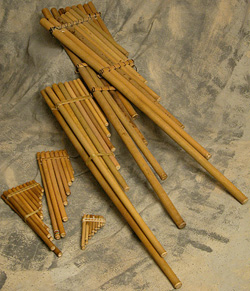 The Andean region of South America, which includes Bolivia, Peru, Equador and Paraguay, has a long history of music played on pan pipes, dating back to the Aymara, Kechua and Inca indians. They consist of one or two rows of different lenghts of hollowed-out cane.
The Andean region of South America, which includes Bolivia, Peru, Equador and Paraguay, has a long history of music played on pan pipes, dating back to the Aymara, Kechua and Inca indians. They consist of one or two rows of different lenghts of hollowed-out cane.
The bottom of each cane is sealed and the player blows across the top to create the note.
All of these flutes are in the key of Gmaj/Emin.
Ecka - The Ecka is the smallest pan pipe in the photo, with 14 reeds in two rows.
Malta & Zanca - These flutes on the right side of the photo have medium length pipes and can either have two rows or one long row.
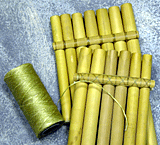 Semi-Toyo and Toyo--The Semi-Toyo (center of photo) and the
Toyo (top of photo) are the large base flutes. Even though they consist of two rows, they are never attached like the smaller flutes. The reason for this is that it takes a lot of air to get the notes out, so two musicians will play alternating notes to create one melody. The pipes are tied together with string or gut (see close-up.)
Semi-Toyo and Toyo--The Semi-Toyo (center of photo) and the
Toyo (top of photo) are the large base flutes. Even though they consist of two rows, they are never attached like the smaller flutes. The reason for this is that it takes a lot of air to get the notes out, so two musicians will play alternating notes to create one melody. The pipes are tied together with string or gut (see close-up.)
* Sukay, Chaskinakuy
Antara and Rondador (So. America)
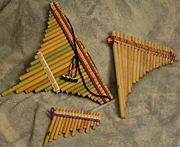 The Rondador (bottom of photo) is a chordal pan pipe with the notes arranged in thirds.
The Rondador (bottom of photo) is a chordal pan pipe with the notes arranged in thirds.
The Antara (top left in photo) is bi-tonal, blowing from the center to the right it's in Gmaj and blowing from the center to the left it's in Dmaj.
The last flute in the photo is a single-rack Siku.
Quena and Quenacho (So. America)
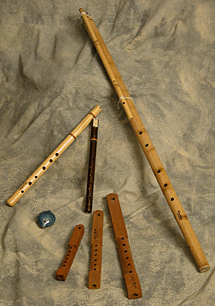
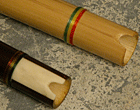 The quena (center of picture) is a notched, end-blown flute, which is made out of cane, in the key of Gmaj. The Queanacho (left side of photo) is pitched lower than the Quena in the key of Dmaj. The mouthpiece can be made out of bone or wood (see close-up)
The quena (center of picture) is a notched, end-blown flute, which is made out of cane, in the key of Gmaj. The Queanacho (left side of photo) is pitched lower than the Quena in the key of Dmaj. The mouthpiece can be made out of bone or wood (see close-up)
* Sukay, Chaskinakuy, Jorge Alfano
Mocseno (So. America)
The mocseno (right side of left photo) is a base flute, made of bamboo, with a double pipe.
Tarkas (So. America)
The Tarkas (bottom of left photo) are three primitive flutes, roughly tuned in fifths. Players will generally play two of them at the same time. Usually played with the Wancara drum.
Ocarina (So. America)
The Ocarina (round, blue flute in above left photo) is decended from the clay whistles of Pre-Columbian South America. The modern Ocarina can range from the very small, Sopranino to the very large Great Base. They can be in a variety of keys and be made out of wood, clay or stone. During World War II, the U.S. Government issued plastic Ocarinas as morale boosters for its soldiers.
Ney (Middle East)
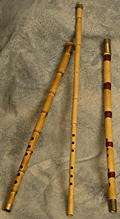
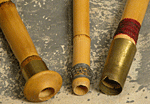 An ancient end-blown cane flute used throughout Egypt, Turkey, Iran, Pakistan and parts of NW India. It has a lovely, breathy sound. In the photo, the flute on the left is a six hole Turkish Ney. It has a flanged mouthpiece. The center flute is a six hole Arabic Ney.
An ancient end-blown cane flute used throughout Egypt, Turkey, Iran, Pakistan and parts of NW India. It has a lovely, breathy sound. In the photo, the flute on the left is a six hole Turkish Ney. It has a flanged mouthpiece. The center flute is a six hole Arabic Ney.
The flute on the right is a Persian Ney. It has a metal mouthpiece (see close-up) which enables the player to get a third octave of notes. Traditional Persian flutes have five holes, but some modern players drill a sixth hole.
This instrument is considered one of the most difficult to master.
* Ali Jihad Racy (Arabic), Hossein Omoumi (Persian), Kudsi Erguner (Turkish)
The Dvoyanka (right side of photo) is a wind instrument originating in Bulgaria. It is a simple, dual-chamber flute, with one chamber being a drone, which creates a hauntingly beautiful sound.
Satara (India)
The Satara (left side of photo) is a dual flute from Rajastan. One flute is used as a drone by filling the holes with wax. The diffuculty in playing these flutes, like the Dvoyanka, is that the drone needs to stay at the same note all the time and the melody flute will chage octaves. When changing octaves, you have to blow harder on the melody side and keep the airstream the same on the drone side. These flutes are all played utilizing circular breathing where the player breathes in through the nose and out through the mouth. The secret to doing this is holding a reservoir of air in the mouth.
Alghoza (Pakistan)
The Alghoza is a similar flute to the Satare, but the drone is longer than the chanter, whereas on the Satara, they are the same length. The Alghoza is played mailnly in Pakistan.
*Jerome Desigaud, Steev Kindwald
These flutes (two on left in photo) are PVC-pipe versions of a traditional overtone flute from Russia. The traditional instrument is made from the Borshvik bush, which makes it very fragile so it usually lasts only one season. Traditionally, this flute is usually made in early autumn when the bush is large, but this bush has poison inside it which can cause irritation of the throat. In modern times more and more are made out of PVC. The Kalyuka is a pure overtone flute (no holes) so the player blows into it on the notched side while fully or partially opening or closing the bottom end, producing a variety of overtones.
Fujara (Slavic)
Traditionally, the Fujara (on right in photo) is made from very hard wood, which is difficult to bore by hand. Very few are produced and hence are very expensive. Making it out of PVD pipe solves both of those problems. The bottom half of the instrument is removable so you can change the key. This Flute has a mouthpiece that you blow into and 3 holes to open and close, so it is not a pure overtone flute, but overtones are used extensively.
Recorders
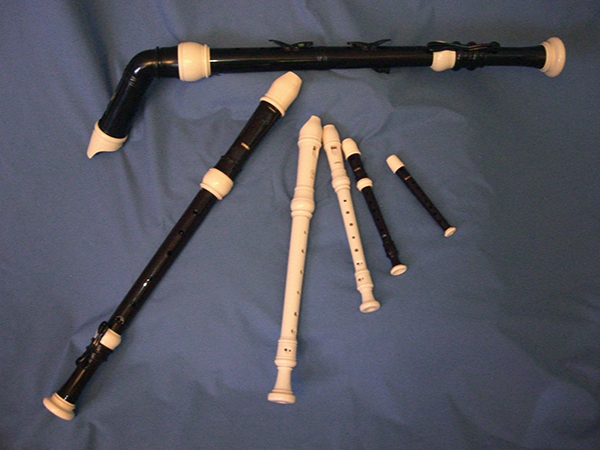
Here is a set representing most of the available recorder sizes. The only one I don't is the largest, contra-bass. The bass recorder is on top and then from left to right are tenor, alto, soprano, sopranino and piccolo. The bass, alto and sopranino are all in the key of F (all holes covered.) The tenor, soprano and piccolo are all in the key of C (all holes covered.)
Harmonicas
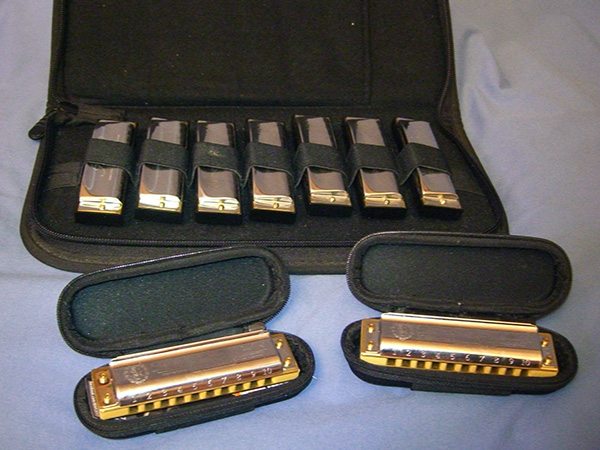
These are the Hohner Blues harps that I use. The set in the big case are their "Special 20s". These are some of the most popular harps used in Blues. Being on the lower end of their line, they have plastic combs. The comb is where you blow into the instrument and where the reeds sit. The two in front are their higher end "Crossover" harps. These have bamboo combs which makes it easier to bend the notes.
*Little Walter, Sunny Terry, Howard Levi, Toots Thielemans, James Cotton, Mark Ford
Trumpets
My latest interest has become the Brass family, specifically C Trumpets. Brass instruments have been around since ancient times, but up until the late 18th Century have been only overtone instruments. The use of piston valves and rotary valves have enabled the Brass family to effectively play in any key. When I first started on the Bb trumpet, I wondered why when reading a concert C note, the instrument played Bb. I was told “That’s the way it is.” I decided I was more interested in reading and hearing the same note. So I had three horns, a Bb Cornet (left)), and a Flugelhorn (center) from the late 1800’s, both converted into C-instruments, as well as a one-of-a-kind C Slide-Trumpet or soprano trombone (right).
These three instruments represent the three ways that Brass instruments play their notes; piston valves on the Cornet, rotary valves on the Flugelhorn and slide on the Slide-Trumpet.
*Miles Davis, Markus Stockhausen, Paolo Fresu, Allison Balsom
Horns
This French Horn (left in photo) is a right-handed horn in C (most French Horns are left-handed), which allows me to play it exactly the same as the Trumpet and Flugelhorn. This one also has a fourth valve that drops the horn into G, or in other words is the same as depressing valves 1 and 3 simultaneously. It can be used to play lower in the range, or it can be used to correct intonation problems with 1+3 and 1+2+3 combinations of valves.
This Practice Alphorn (right in photo) is pitched the same as the traditional 12-ft Swiss horns, but is easier to travel with. It is made using a French Horn lead pipe, first branch and bell tail. An additional 8 - 9 ft of tubing is then added to put the horn into the key of F, and then a French Horn mouthpiece receiver is used at the end. All my brass instruments are custom built by Lindsey Jones of Silver & Brass in Carson City, NV.
Photos with grey background by Gary Jameson, Reno, NV, (775) 825-8999.
